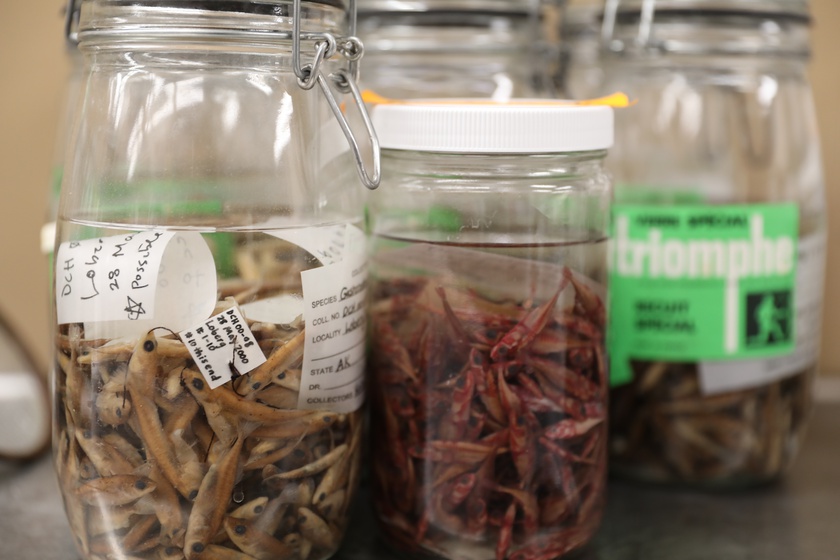{shortcode-194cba5c77f25f8b1dafb4bc0c647586f15fc7d4}
Across rows of floor-to-ceiling shelves in the basement room of the Harvard Museum of Comparative Zoology, mason jars labeled with scraps of paper are filled to the brim with silver, finger-sized fish.
“We have about a million and a half individual fish specimens,” Andrew D. Williston, a collection manager at the MCZ, says. He specializes in ichthyology, the branch of zoology that studies fish. “It’s going to be much higher after we count all the sticklebacks.”
After the museum processes its newest donation, the collection will include half a million skeletons of three-spined stickleback fish alone.
Now, the Harvard Ichthyology collection at the MCZ is in the middle of a year-long process to curate and catalog these fish that, once completed, will help inform ichthyology and evolutionary research at large.
Three-spined stickleback fish have long fascinated researchers because of their ability to rapidly adapt to new environments.
The species initially inhabited oceans in the northern hemisphere and developed heavy scales as protection from predators. As the Ice Age ended, glaciers retreated, and freshwater lakes emerged. Small populations of stickleback “invaded” these ponds, according to Williston. As time went on, different populations adapted to their environmental niche and developed unique characteristics. Some freshwater sticklebacks, for example, completely lack body armor.
Each of the ponds is “its own little evolutionary experiment,” Williston says.
In the late 1980s, former Clark University biology professors John A. Baker and Susan A. Foster, a husband-wife duo, set out to investigate each of these natural experiments. They spent 30 years sampling water and tracking fish in over 90 freshwater lakes across Alaska and taking meticulous notes.
Sticklebacks, it turns out, can adapt to changing environments with lightning speed. The fish can evolve from oceanic to freshwater environments in mere decades, much faster than Charles Darwin’s model of gradual evolution predicts.
This makes sticklebacks prime research subjects. The data collected by the Baker & Foster Lab would come to inform over 70 published scientific papers. For the lay audience, they also ran a “Stickleblog” starting in 2008.
With Foster’s death and Baker’s deteriorating health, their collection needed to relocate, and the most logical choice was the Harvard MCZ, which was less than an hour drive away.
“My personal highlight was meeting John Baker, and getting to see his passion for these fish,” Williston says. Baker passed away in June 2021, just weeks before the specimens left for their new home in the MCZ.
A moving company transported well over 2,000 mason jars, each filled with 50 to 300 sticklebacks, and new shelves were built to house the half million new specimens.
{shortcode-6c79627dca65e23542615fd5a25f5ffedb3d1526}
And this was only the beginning. Currently, curators are manually transferring the specimens from Baker’s and Foster’s decade-old jelly jars filled with formaldehyde to new, labeled jars filled with ethanol solution. This process will take at least another year; not a single skeleton of the half million will be discarded.
Anne W. Everly, a lab manager at MCZ, has been doing much of this manual labor and finds it a fulfilling experience. “Every aspect of what we do, I’ve gotten to do with these fish,” she says. “The only thing I missed out on, of course, was the collecting — which is probably the best part.”
Once the curation is complete, Williston says, they will digitize the specimens. He hopes that the MCZ’s online database will become a central resource for researchers across the country who are investigating sticklebacks.
“Anybody in the world who has an interest in three-spined sticklebacks can log into our catalog and see where our specimens came from and if we have material that they need for their studies,” Williston says.
“There’s a whole community of researchers who focus on three-spined sticklebacks,” he adds. “I hope that we, as a collection, can connect with those researchers more and develop more interest in these specimens.”
— Magazine writer Talia H. Kahan can be reached at talia.kahan@thecrimson.com. Follow her on Twitter @kahan_talia.


